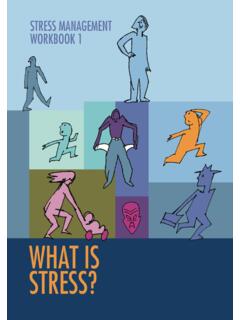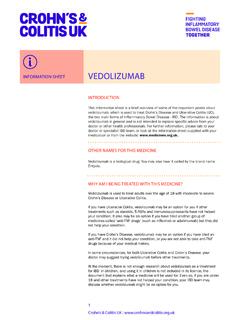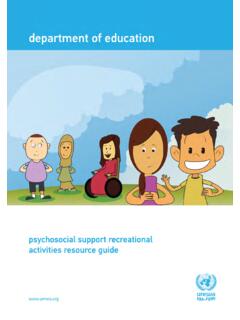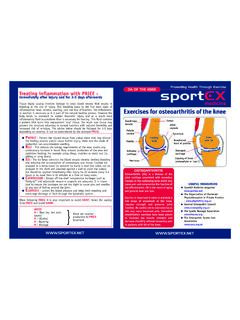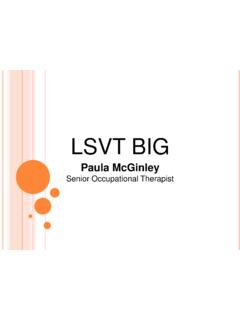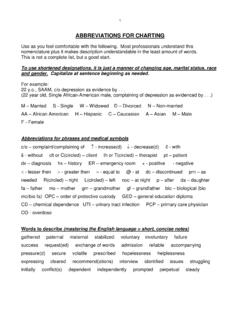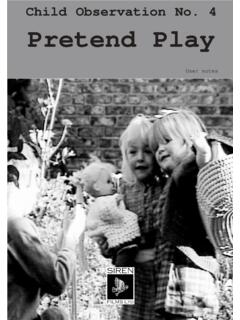Transcription of CBT for Panic Disorder - NJCTS
1 Slide 1 Rachel Strohl, _____ _____ _____ _____ _____ _____ _____ Slide 2 CBT for Panic DisorderThe goal is NOT to end anxiety. That s impossible. The goal is NOT to end Panic attacks. That s beyond our control. The goal is to learn how to normalize and respond effectively to anxiety. If you learn to accept that Panic attacks can happen but are not to be feared, you no longer have Panic unpleasant, Panic attacks are only a problem if they control your choices. Fortunately, Panic can t control your choices. You are always in charge. Therefore, Panic is not a problem; it s just temporary pain. _____ _____ _____ _____ _____ _____ _____ Slide 3 Our goals for today We will differentiate Panic attack symptoms in several of the common anxiety disorders.
2 We will learn how to assess and diagnose Panic Disorder . We will discuss some of the hypotheses behind why someone has Panic attacks. We will review Cognitive Behavioral Therapy (CBT) protocol for the treatment of Panic Disorder for adults. _____ _____ _____ _____ _____ _____ _____ Slide 4 Panic Disorder DSM-V criteria Criteria A:Recurrent and often unexpected Panic attacks. An anxiety Disorder based primarily on the occurrence of Panic attacks. At least one Panic attack is followed by a month or more of the person fearing that they will have more attacks. Panic vs. anxiety share some symptoms but differ in intensity, duration, and whether or not there is a trigger. _____ _____ _____ _____ _____ _____ _____ Slide 5 Panic Symptoms A Panic attack is an abrupt surge of intense fear or intense discomfort that reaches a peak within minutes, and during which time 4 (or more) of the following symptoms occur: 1.
3 Palpitations, pounding heart, or accelerated heart rate 2. Sweating 3. Trembling 4. Sensations of shortness of breath 5. Feelings of choking 6. Chest pain or discomfort 7. Nausea or abdominal distress _____ _____ _____ _____ _____ _____ _____ Slide 6 Panic Symptoms 8. Feeling dizzy, unsteady, lightheaded, or faint 9. Chills or heat sensations 10. Parasthesias (numbness or tingling sensations) 11. Derealization (feelings of unreality) or depersonalization (being detached from one self ) 12. Fear of losing control or "going crazy 13. Fear of dying _____ _____ _____ _____ _____ _____ _____ Slide 7 DSM-V Criteria Criteria B: At least one of the attacks has been followed by one month (or more) of one or both of the following: 1.
4 Persistent concern or worry about additional Panic attacks or the consequences. 2. A significant maladaptive change in behavior related to the attacks (typically avoidance). Criteria C: Panic is not better explained by a medical condition. Criteria D: Panic is not due to another psychological Disorder . _____ _____ _____ _____ _____ _____ _____ Slide 8 Why do People Panic ? Suffocation Alarm Theory: I can t get enough air. Something is wrong! Danger! A catastrophic misinterpretation of physiological response. Conditioning: Some subconscious connection was made with an environment or stimuli, through conditioning, that triggers a Panic response. _____ _____ _____ _____ _____ _____ _____ Slide 9 Why do People Panic ?
5 The Fight or Flight response A physiological reaction that occurs in response to a perceived harmful event, attack, or threat to is important to help the patient see Panic as a normal biological process that is not dangerous, while empathizing how unpleasant it is. It feels harmful, but it s the body trying to be acceptance of normal anxiety helps patients learn not to overreact to symptoms that precede Panic . Our job is to help them to learn how to respond peacefully and effectively. _____ _____ _____ _____ _____ _____ _____ Slide 10 Exclusion Criteria The following may trigger Panic attacks, but if that s the case then technically you wouldn t diagnose Panic Disorder , because the Panic attack is not unexpected: OCD/Health Anxiety PTSD Social Anxiety Specific Phobias Emetophobia _____ _____ _____ _____ _____ _____ _____ Slide 11 Social Anxiety Disorder Excessive and persistent fear that others are evaluating you.
6 Fear that you will do or say something that is embarrassing, will make you look bad, or will make you the center of unwanted attention. As a result, the sufferer will actively avoid social situations where evaluation may occur. The sufferer acknowledges that their fear is overblown. _____ _____ _____ _____ _____ _____ _____ Slide 12 Generalized Anxiety Disorder Characterized by excessive, uncontrollable and often irrational worry about everyday things that is disproportionate to the actual source of worry. Catastrophize, anticipate disaster, and are overly concerned about everyday matters such as health issues, money, death, family or friends problems, or work difficulties. They often exhibit a variety of physical symptoms, including fatigue, fidgeting, headaches, nausea, numbness in hands and feet, muscle tension, muscle aches, bouts of difficulty breathing, trembling, twitching, irritability, sweating, and hot flashes.
7 _____ _____ _____ _____ _____ _____ _____ Slide 13 Obsessive Compulsive DisorderOBSESSIONS: Recurrent and persistent thoughts, impulses, or images that are experienced at some time during the disturbance, as intrusive and inappropriate and that cause marked anxiety or distress. The thoughts, impulses, or images are not simple excessive worries about real life problems. The person attempts to ignore or suppress the thoughts or neutralize them. The person recognizes these thoughts as a product of his/her own mind. _____ _____ _____ _____ _____ _____ _____ Slide 14 Obsessive Compulsive DisorderCOMPULSIONS: Repetitive behaviors ( , hand washing, ordering, checking) or mental acts( , praying) that person feels driven to perform in response to an obsession or rules.
8 The behaviors or mental acts are aimed at preventing or reducing distress, or preventing a dreaded event or situation. Behaviors or mental acts are not connected to thoughts in any realistic way. _____ _____ _____ _____ _____ _____ _____ Slide 15 Cognitive Behavioral Therapy (CBT) Tends to be more structured then traditional talk therapy. Involves teaching skills and having patients practice these skills between sessions . It not about venting to a supportive person, but rather learning strategies for dealing with emotions and life more effectively. Routinely shown to be effective in random controlled trial research, which is why it s the form of psychotherapy with the most empirical validation. CBT is often referred to as evidence based treatment for anxiety and depression.
9 _____ _____ _____ _____ _____ _____ _____ Slide 16 Cognitive Behavioral Therapy (CBT) Evaluation Psychoeducation Relaxation/meditation Cognitive Restructuring Exposure Therapy _____ _____ _____ _____ _____ _____ _____ Slide 17 Self-monitoring form Panic Attack Record Date:_____Time Began:_____Expected UnexpectedMaximum Fear(1 to 10): _____ Time Ended: _____(circle one) Triggers:_____ _____ _____ Symptoms:Difficulty BreathingNausea/Abdominal painUnsteadiness/Dizziness/Faintness (circle all symptomsRacing/Pounding HeartChest Pain/DiscomfortFear of Dying present to at least a mildChokingHot/Cold FlashesFear of Losing Control/Going Crazy degree) Trembling/ShakingFeelings of Unreality/ Out of Body Experience _____ Panic Attack Record Date:_____Time Began:_____Expected UnexpectedMaximum Fear(1 to 10): _____ Time Ended: _____(circle one) Triggers:_____ _____ _____ Symptoms.
10 Difficulty BreathingNausea/Abdominal painUnsteadiness/Dizziness/Faintness (circle all symptomsRacing/Pounding HeartChest Pain/DiscomfortFear of Dying present to at least a mildChokingHot/Cold FlashesFear of Losing Control/Going Crazy degree) Trembling/ShakingFeelings of Unreality/ Out of Body Experience _____ _____ _____ _____ _____ _____ _____ Slide 18 Psychoeducation If the Panic is based in health anxiety, review recent medical history or recommend a check up at the onset of treatment. Then, limit checking and safety behaviors moving forward. Explain CBT protocol for the treatment of Panic . Explain that the therapy focuses on learning skills that he/she can keep working on between sessions and to maintain treatment gains beyond termination of treatment.
